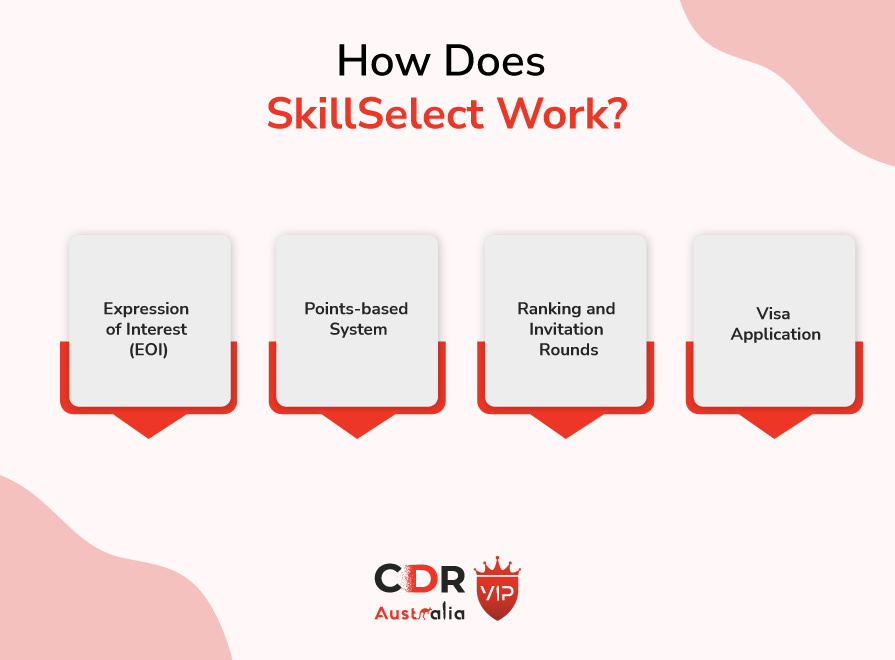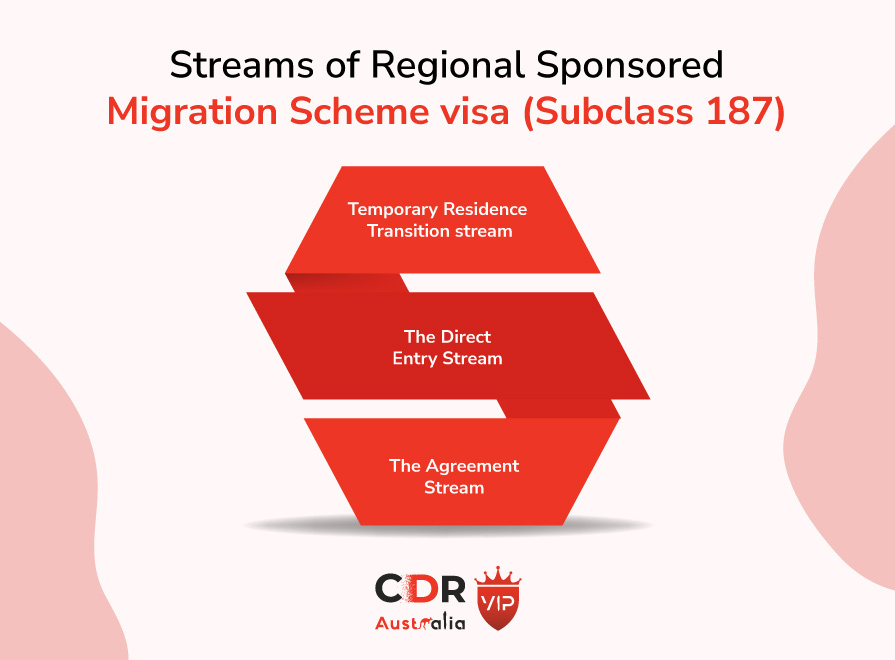What is SkillSelect and how does it work?

What is SkillSelect and how does it work?
In Australian immigration, SkillSelect is a critical mechanism revolutionizing how skilled migration gets managed. As a digital platform established by the Australian government, SkillSelect has brought efficiency, transparency, and accessibility to the skilled migration process.
SkillSelect serves as a pivotal online portal through which skilled individuals from across the globe can express their interest in migrating to Australia. Operating on a points-based system, SkillSelect evaluates candidates based on diverse factors, including age, English language proficiency, qualifications, work experience, and nominated occupation.
The initial step in the SkillSelect process entails presenting an Expression of Interest (EOI) via the official SkillSelect website. The EOI comprises detailed information about your skills, qualifications, and work experience, as well as your preferences for visa subclass and desired location within Australia.
Once lodged, your EOI enters a pool of candidates awaiting potential invitations to apply for a visa. The Australian government conducts regular invitation rounds to select candidates with the highest points and the most relevant skills and qualifications, aligning with the needs of the Australian labor market.
The points-based system is central to the SkillSelect process, whereby each factor, such as age, English language proficiency, and work experience, carries assigned points. Accumulating a higher number of points enhances your prospects of achieving an invitation to apply for a visa. It’s important to note that the minimum points required for an invitation vary depending on the demand for specific skills and occupations.
SkillSelect has streamlined the skilled migration process and bolstered its efficiency. By enabling the Australian government to manage skilled migration effectively, SkillSelect ensures that the country’s economic and labor needs get met while offering qualified individuals the opportunity to contribute to Australia’s growth and development.
We will get into the intricate workings of SkillSelect, offering valuable insights and guidance on effectively navigating the system. We will explore essential components such as the EOI, the points system, the invitation process, and the diverse visa subclasses available through SkillSelect.
By the end of this journey, you will possess a comprehensive understanding of SkillSelect, empowering you to take confident steps toward getting maximum points for Australian immigration.
How does SkillSelect work?
SkillSelect is an online platform the Australian Department of Home Affairs (DHA) uses to manage the skilled migration program. It operates through a step-by-step process that enables experienced individuals to express their interest in migrating to Australia and potentially be invited to apply for a skilled visa.
Here is a detailed guide to understanding how SkillSelect works:

1. Expression of Interest (EOI)
The first step in the SkillSelect process is submitting an Expression of Interest (EOI) through the online portal. The EOI is a preliminary application where individuals provide comprehensive information about their skills, qualifications, work experience, English language proficiency, and other relevant details.
It is crucial to accurately and honestly complete the EOI, as this information will get used to assess your eligibility for skilled migration.
2. Points-based System
SkillSelect operates on a points-based system, where individuals get awarded points based on various factors. These factors include age, English language proficiency, educational qualifications, work experience, and nominated occupation.
The issues get calculated using the SkillSelect Points Test, which assigns different values to each factor. Applicants generally need to score at least 65 points to be eligible for skilled migration. However, it is essential to note that higher point scores increase the chances of receiving an invitation to apply for a visa.
3. Ranking and Invitation Rounds
Once an EOI is submitted, the individual’s profile gets ranked within their nominated occupation group based on the points obtained. The highest-ranking candidates in each occupation get considered for invitation rounds.
The Australian government periodically conducts invitation rounds, inviting candidates with the highest points in their occupation group to apply for skilled visas. The number of invitations issued in each round depends on the availability of positions and the government’s migration planning levels.
It is essential to understand that receiving an invitation is not guaranteed, as the number of invitations issued can vary based on the government’s priorities and the demand for specific occupations. Therefore, having a competitive points score and keeping the EOI updated with accurate information is crucial.
4. Visa Application
If an individual receives an invitation to apply for a skilled visa, they must submit a complete visa application within the specified timeframe, usually 60 days. The visa application requires detailed supporting documentation, such as proof of skills assessment, educational qualifications, work experience, English language proficiency test results, and health and character checks.
The Department of Home Affairs carefully assesses the visa application, where they verify the information provided and determine if the applicant meets all the eligibility requirements for the nominated visa subclass. If your application is successful, the applicants will get granted a visa to live and work in Australia as a skilled migrant.
Must Read: Top 10 most-demanded engineering fields in Australia 📚📚
SkillSelect Occupation Lists
SkillSelect refers to occupation lists that outline the occupations in demand in Australia. These lists include the Medium and Long-term Strategic Skills List (MLTSSL) and the Short-term Skilled Occupation List (STSOL). Skilled visas are usually granted for occupations listed on the MLTSSL, while the STSOL gets utilized for specific visa categories and temporary visas.
a. Medium and Long-term Strategic Skills List (MLTSSL)
The MLTSSL consists of occupations considered critical to Australia’s long-term growth and development. Occupations included in the MLTSSL are in high demand and often reflect the skills and expertise needed to address skill shortages in the country.
Skilled professionals with occupations on the MLTSSL may be eligible for a range of visas, including the Skilled Work Regional (Provisional) visa (subclass 491) and the Skilled Independent visa (subclass 189).
The MLTSSL gets regularly reviewed and updated to ensure it aligns with the evolving needs of the Australian labor market. This process considers emerging industries, technological advancements, and economic priorities.
Occupations listed on the MLTSSL are typically high-skilled, requiring specific qualifications, expertise, and work experience. Meeting the criteria for an occupation on the MLTSSL can provide skilled migrants with the opportunity to obtain permanent residency in Australia.
b. Short-term Skilled Occupation List (STSOL)
The STSOL comprises occupations in demand in the short term to address immediate skill shortages in Australia. Occupations listed on the STSOL are eligible for visas such as the Skilled Nominated visa (subclass 190) and the Employer Nomination Scheme (ENS) visa (subclass 186).
However, it is essential to note that while some STSOL occupations may still lead to permanent residency, others may have restrictions or require additional criteria to get met. Like the MLTSSL, the STSOL gets regularly reviewed to ensure it reflects the immediate skill requirements of different states and territories within Australia.
The occupations included on the STSOL can range from high-demand professions to niche roles, depending on the specific industry and region. Skilled professionals must carefully review both the MLTSSL and the STSOL to assess the suitability of their occupation for skilled migration to Australia.
Including occupation on either list can significantly impact the available visa options and the potential pathways to permanent residency. It is essential to consult official government sources or seek professional advice to stay updated with any list changes and understand the specific requirements associated with each occupation.
Read More: Step-by-step process to get an Australian PR in 2023 💪💪
What are the Skilled Worker Visa Categories?
1. Skilled Independent visa (subclass 189)
Skilled Independent visa (subclass 189) is a highly sought-after visa category for skilled workers looking to migrate to Australia. It provides a pathway to permanent residency without needing sponsorship by an employer or nomination by a state or territory government.
This visa category gets designed for individuals with in-demand skills and qualifications to contribute to the Australian economy. To get eligible for the subclass 189 visa, applicants must meet the minimum points threshold based on various factors such as age, English language proficiency, qualifications, work experience, and nominated occupation.
The points-based system is used to assess the suitability of applicants, and a minimum of 65 points is typically required. The higher the points scored, the greater the chance of being invited to apply for the visa. One of the key advantages of the subclass 189 visa is its location and occupation choice flexibility.
As there is no requirement for state or territory nomination, applicants can live and work anywhere in Australia and pursue their desired career path. This visa category is particularly suitable for individuals who prefer control over their migration journey and want to explore various opportunities across the country.
2. Skilled Nominated visa (subclass 190):
The Skilled Nominated visa (subclass 190) is another pathway to permanent residency for skilled workers. This visa category requires a state or territory government nomination, which means applicants must meet the specific criteria set by the nominating authority and satisfy the points requirement.
State and territory governments nominate candidates based on their skills, qualifications, and the demand for specific occupations in their region. The subclass 190 visa offers additional points for state or territory nomination, enhancing the chances of receiving an invitation.
This visa category allows individuals to settle in a particular state or territory and contribute to the regional economy. The subclass 190 visa offers several benefits, including priority processing, access to a broader range of occupations, and additional points.
It allows applicants to align their skills and qualifications with the needs of specific regions, increasing the likelihood of a successful migration outcome. This visa category is ideal for individuals who prefer a particular state or territory and wish to contribute to the regional workforce.
3. Skilled Work Regional (Provisional) visa (subclass 491):
The Skilled Work Regional (Provisional) visa is a regional visa category that encourages skilled workers to live and work in designated regional areas of Australia. This visa requires either state or territory government nomination or sponsorship by eligible family members residing in a designated regional area.
The subclass 491 visa allows individuals to live and work in regional Australia for up to five years. It offers a pathway to permanent residency through the upcoming subclass 191 visa. This visa category allows individuals to contribute their skills and expertise to the development and growth of regional communities in Australia.
One of the key advantages of the subclass 491 visa is the priority processing it receives. Regional migration is a priority for the Australian government, and this visa category aims to attract skilled workers to areas that require specific skills. By living and working in regional Australia, individuals can relish the benefits of a vibrant community, a lower cost of living, and potential opportunities for long-term settlement.
Read more: Computer Engineer Jobs in Australia 💼💼
4. Employer Nomination Scheme (ENS) visa (subclass 186)
The Employer Nomination Scheme (ENS) visa provides skilled workers a pathway to PR (permanent residency) in Australia through employer sponsorship. The ENS visa consists of three streams: the Temporary Residence Transition stream, the Agreement stream, and the Direct Entry stream.
The ENS visa offers several benefits, including a direct pathway to permanent residency, the opportunity to work for a specific employer, and the ability to contribute to the Australian workforce meaningfully. It provides stability and security for skilled workers and their families, allowing them to establish their lives in Australia.
5. Regional Sponsored Migration Scheme (RSMS) visa (subclass 187)
Regional Sponsored Migration Scheme (RSMS) visa is a visa category that targets regional Australia. It allows skilled workers to obtain permanent residency through employer sponsorship in designated restricted areas. The RSMS visa also consists of three streams: the Agreement stream, the Direct Entry stream, and the Temporary Residence Transition stream.

-
Temporary Residence Transition stream
The Temporary Residence Transition stream is similar to the ENS visa’s Temporary Residence Transition stream. It allows temporary visa holders to transition to permanent residency if they have worked for at least three years in the same occupation with the same employer in regional Australia.
-
The Direct Entry Stream
The Direct Entry stream is for individuals who get nominated by an employer and have not worked in Australia or have worked in Australia for a very short period. This stream requires a positive skills assessment to demonstrate that the applicant’s skills and qualifications meet the requirements for the nominated occupation.
-
The Agreement Stream
The Agreement stream is for individuals an employer nominates through a labor agreement specifically for regional areas.
The RSMS visa allows skilled workers to contribute to the development and growth of regional communities in Australia while enjoying the benefits of permanent residency. It offers stability and long-term settlement options in regional areas, which can provide a rewarding and fulfilling lifestyle for individuals and their families.
Successful tips for success in the SkillSelect procedure
Below are the tips for success in the SkillSelect procedure:
-
Complete and Accurate Profile
To increase or maximize the chances of receiving an invitation, providing complete and accurate information in the EOI is crucial. Any false or misleading information can result in the application getting rejected or visa cancellation at a later stage.
-
Maximize Points
To compete in the SkillSelect ranking system, individuals should maximize their points. These points can get achieved by obtaining higher English language proficiency, gaining additional qualifications, acquiring relevant work experience, and securing state or territory nomination.
3. Stay Updated with Occupation Lists
Given that occupation lists can change periodically, staying updated with the latest changes is essential. Regularly checking the occupation lists will help individuals determine if their nominated occupation is still in demand and eligible for skilled migration.
4. Seek Professional Assistance
Navigating the SkillSelect process can be complex, and seeking professional assistance from migration agents or consultants can provide valuable guidance. These professionals have expertise in the skilled migration process and can help individuals understand the requirements, optimize their profiles, and increase their chances of success.
Read More: Onshore and Offshore Visa Application 💪💪
Conclusion
SkillSelect has revolutionized the skilled migration program in Australia by providing a transparent and efficient platform for skilled workers to express their interest in migrating.
By understanding how SkillSelect works and following the tips for success, individuals can enhance their chances of receiving an invitation and realizing their dreams of migrating to Australia. SkillSelect’s targeted selection process, transparency, and flexibility make it a crucial component of Australia’s skilled migration framework.


